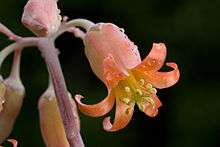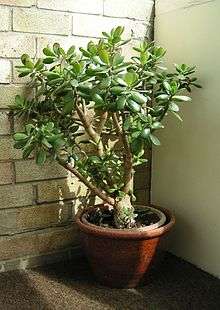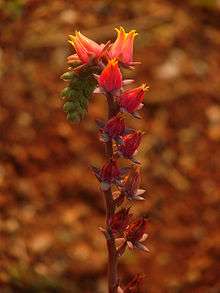Crassulaceae
The Crassulaceae, also known as the stonecrop family or the orpine family, are a family of dicotyledons with succulent leaves. They are generally herbaceous but there are some subshrubs, and relatively few treelike or aquatic plants. They are found worldwide, but mostly occur in the Northern Hemisphere and southern Africa, typically in dry and/or cold areas where water may be scarce. The family includes approximately 1400 species and 34 or 35 genera.,[2][3] although the number of genera is disputed and depends strongly on the circumscription of Sedum.
No member of this family is an important crop plant, but many are popular for horticulture; many members have a bizarre intriguing appearance, and are quite hardy, typically needing only minimal care. Familiar species include the jade plant or "friendship tree", Crassula ovata, and "florists' kalanchoe", Kalanchoe blossfeldia.
Taxonomy

Crassulaceae is a monophyletic group within the core eudicots as a primitive member of the Rosidae, and classified in the order Saxifragales.[1] Some older classifications included Crassulaceae in Rosales, but newer schemes treat them in the order Saxifragales. Classification within the family is difficult because many of the species hybridize readily, both in the wild and in cultivation.
Six subfamilies of Crassulaceae were described by Berger in 1930:[4] Crassuloideae, Kalanchiodeae, Cotyledonoideae, Sempervivoideae, Sedoideae, and Echeveroideae. Though various revisions since have proposed four, three, and two subfamilies, many botanists still use Berger's classification,[5] although some of the subfamilies are polyphyletic.
Molecular phylogenetics has shown that morphological characters and chromosome numbers are so labile in the family that they cannot be used reliably to infer evolution, even at low taxonomic levels.[5]
Crassulacean acid metabolism (CAM photosynthesis) is named after the family, because the pathway was first discovered in crassulacean plants. It is one of the few families that still has CAM as an active, photosynthetic pathway, and is unique in which all its members are known to possess CAM.[6]
Evolution
Crassulaceae evolved approximately 100–60 million years ago in Eastern Africa or in the Mediterranean region,[2] though Africa is more widely recognized as the place of origin.[6] Other sources suggest that Crassulaceae evolved approximately 70 million years ago together with families Penthoraceae and Haloragaceae.[5] The taxon is considered to have a gradual evolution, whereas there is a basal split between Crassuloideae and the rest of the family. The Crassuloideae lineage migrated into Southern Africa and other genera within Sedoideae migrated to Europe, Asia, Northern and Central America.[2]
Genera
Genera in the family include:[7]
- Adromischus
- Aeonium
- Aichryson
- Cotyledon
- Crassula
- Diamorpha[8]
- Dudleya
- Echeveria
- Graptopetalum
- Hylotelephium
- Hypagophytum
- Jovibarba
- Kalanchoe
- Lenophyllum
- Meterostachys
- Monanthes
- Orostachys
- Pachyphytum
- Perrierosedum
- Prometheum
- Pseudosedum
- Rhodiola
- Rosularia
- Sedum
- Sempervivum
- Thompsonella (Mexico)
- Tylecodon
- Umbilicus
- Villadia
References
- 1 2 Angiosperm Phylogeny Group (2009). "An update of the Angiosperm Phylogeny Group classification for the orders and families of flowering plants: APG III" (PDF). Botanical Journal of the Linnean Society. 161 (2): 105–121. doi:10.1111/j.1095-8339.2009.00996.x. Retrieved 2013-07-06.
- 1 2 3 't Hart, H. (1997). Diversity within Mediterranean Crassulaceae. Lagascalia, 1-2, 93-100.
- ↑ Christenhusz, M. J. M.; Byng, J. W. (2016). "The number of known plants species in the world and its annual increase". Phytotaxa. Magnolia Press. 261 (3): 201–217. doi:10.11646/phytotaxa.261.3.1.
- ↑ Berger, A. 1930. Crassulacaeae. In Die naturlichen Pflanzenfamilien Ed. Engler A., and Prantl, K. Volume 18A, p. 352-483. Verlag von WEngelmann, Leipzig.
- 1 2 3 Gontcharova, S. B. and Gontcharov, A. A. (2008), "Molecular Phylogeny and Systematics of Flowering Plants of the Family Crassulaceae DC.", Molecular Biology, 43 (5): 794–803, doi:10.1134/S0026893309050112
- 1 2 Thiede, J., & Eggli, a. U. (2007). Crassulaceae. The Families and Genera of Vascular Plants, 9, 83-118.
- ↑ "Crassulaceae", The Plant List, retrieved 31 July 2016
- ↑ USDA PLANTS, retrieved 31 July 2016
- Urs Eggli, ed. Illustrated Handbook of Succulent Plants: Crassulaceae (Springer, 2003) ISBN 3-540-41965-9
External links
| Wikimedia Commons has media related to Crassulaceae. |
 Data related to Crassulaceae at Wikispecies
Data related to Crassulaceae at Wikispecies- Crassulaceae page
- Crassulaceae in Topwalks


